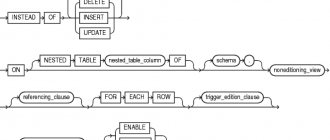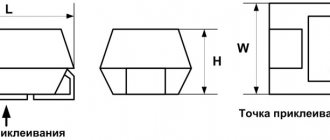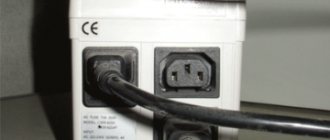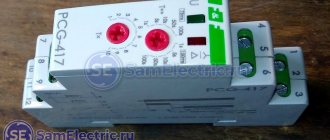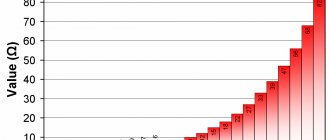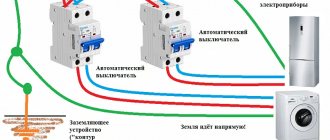To perform logical operations, the binary number system is used. It is used to operate automated power supply protection units and supercomputers that perform weather forecast calculations. A trigger is a typical component of simple and complex control, management, and computing systems. Devices in this category maintain a specific state (0 or 1), which changes with the appropriate combination of input signals. Using a special mechanism, it resets the “memory” to its original or undefined state.
Symmetrical trigger assembled according to a standard circuit using bipolar transistors
In this publication, in addition to types of triggers, hardware and software are discussed. Examples of typical circuit solutions will be useful for creating workable structures with your own hands.
Story
A functional trigger can be created from a conventional relay with an electromechanical drive. By properly setting the control circuit contacts, the power group is turned on after a certain combination of input signals. A separate key performs a reset.
RS trigger circuit on one relay
Electronic analogues were assembled at the beginning of the last century from lamp devices. The current schemes were first published by Russian and English scientists in 1918-20. Later, semiconductor transistors began to be used. Nowadays, corresponding devices are created using microelectronic technologies.
Definitions
Voltage unit
Given the excessive diversity, the terminology used should be clarified. The following list contains correct answers to the question what is a trigger:
- a device for recording (storing) data that supports two equilibrium states;
- base memory cell;
- switching element with several stability positions;
- a logical component capable of transitioning to the “1” or “0” state with direct and reverse (inverse) output.
Schmitt trigger with independent adjustment of hysteresis and trigger levels
To independently adjust the parameters of the Schmitt trigger, a buffer element (very often an emitter follower) is connected between transistors VT1 and VT2. As a result, the influence of resistor R3 on the voltage divider R4R6 is reduced, and the sensitivity of the circuit as a whole increases.
Schmitt trigger circuit with a buffer element.
Classification
Capacitor energy
Products in this category are divided into two main groups based on the principle of control signals. In the first, a specified sequence of output signals is generated if the state is set to “1”. After moving to “0”, generation stops. The second is capable of switching the output voltage accordingly. Typically, "1" roughly corresponds to the power supply level.
Triggers are also distinguished according to the following parameters:
- synchronization of work cycles;
- static (dynamic) control methods;
- complexity of logic circuits;
- one- or two-stage.
Triggers on logic elements and on an operational amplifier
An amplifier circuit with two stages is well suited for implementing static triggers. The connection between them is organized directly or with limiting resistors in the corresponding circuits.
Trigger on logical elements
Schmitt Trigger
Products in this category can be created using different element bases. This section discusses the Schmitt trigger on transistors. It is controlled by changing an analog signal. Depending on the voltage level, the memory state is switched to the corresponding position “0” or “1”.
Schmidt trigger on transistors with a connected load
Transients in a trigger
Let us consider in more detail the transient processes occurring in the trigger when it is switched.
Due to the inertia of transistors and the presence of parasitic capacitances, the trigger switching does not occur instantly, but over a finite period of time. The nature and duration of the transient switching process depend on the parameters and structure of the circuit, as well as on the triggering method and parameters of the trigger pulses (amplitude, duration, shape). Let's consider transient processes when the trigger is launched separately.
Let us continue to assume that in the initial state, transistor T1 is open and saturated, and T2 is closed, and let a positive triggering current pulse enter the base of the open transistor. Under its influence, the process of resorption of minority carriers in the base of the saturated transistor begins and after some time tp (Fig. 2) this transistor will be at the saturation limit. From this moment, its collector current begins to decrease, which leads to an increase in the negative voltage on the collector Uk1. This will cause a decrease in the positive bias voltage Ub2 at the base of the closed transistor T2. The time tn during which the positive bias voltage decreases from the initial value to zero is called the time of preliminary formation of the negative front on the collector T1. The sum tp+tn is called the preparation time. After this time, i.e. after reaching Ub2 = 0, transistor T2 opens, the gain in the positive feedback loop is restored, and an avalanche-like rollover process (regenerative process) occurs in the trigger during the time treg.
Fig.2 Diagram. Transient processes in a trigger.
Indeed, when transistor T2 opens, current ik2 appears in its collector circuit. The increment of this current goes to the base of transistor T1 and, adding to the input blocking current pulse, helps turn off transistor T1. The collector current ik1 of turn-off transistor T1 decreases. The reverse increment of current ik1 is transmitted to the base of the opening transistor T2, causing it to open even more, etc. The avalanche-like process ends with the closing of the transistor T1 and the opening of T2. In this case, the positive feedback between the cascades is interrupted again.
The duration treg of the stalling interval constitutes a significant fraction of the total duration of the transition process. By the time the overturning ends, with sufficiently large accelerating capacitors, the change in the base current |Δ ib2| in the unlocking transistor T2 is equal in magnitude to the change in collector current |Δ ik1| turn-off transistor T1. The greater the base current at the end of the rollover, the faster the voltage is established at the collector of the unlocking transistor.
The establishment of voltages and currents on the collectors and bases of transistors occurs for some time tset when the accelerating capacitors C1 are recharged.
Before the start of the triggering pulse, capacitor C1′ was discharged, and C1″ was charged to a voltage close to Ek. When the trigger flips, capacitor C1′ is charged by the current taken from the base of transistor T2 through the circuit: plus power source Ek, input resistance of transistor T2, capacitor C1′ resistor Rk' minus source Ek. The charging time of the capacitor is determined by the time constant of the charging circuit tcharge=C1Rk. The charging current creates a voltage drop across the resistance Rk'. Thus, the increase in the negative potential of the collector of the closing transistor will end when the charging current stops, i.e. capacitor C1′ will charge. Consequently, the charging time of capacitor C1′ determines the negative edge t(-)f of the output voltage. The smaller the accelerating capacitance, the smaller the negative edge. Upon completion of charging of capacitor C1′, the base current of transistor T2 becomes less, it is determined by the resistances of resistors R1 and R2.
From the analysis of transistor switches it is known that the higher the base current the transistor is turned on, the faster its turn-on time, i.e. in short, the positive front t(+)f (for pnp type transistors). It is also obvious that as capacitor C1′ charges, the charging current decreases. Consequently, if the capacity of the accelerating capacitor is small, then the capacitor will have time to charge before the trigger ends. Then the base current of the unlocking transistor will noticeably decrease even before the end of unlocking the transistor, and the rise front of the collector current and collector voltage (positive front t(+)ph) will increase. Thus, to reduce the negative edge of the output voltage, you need to reduce the capacitance of the accelerating capacitors, and to reduce the positive edge, increase it.
When the trigger flips over, capacitor C1″ gets the opportunity to discharge through two circuits: a) left plate C1″, resistor R2′, bias source, emitter-collector resistance T2, right plate C1″; b) left plate C1″, resistance R1″, right plate C1″. Due to the discharge of capacitor C1″, the voltage Ub1 at the base of transistor T1 turns out to be positive and greater than the stationary value of the turn-off voltage (dynamic bias). As capacitor C1″ discharges, the discharge current decreases and Ub1 tends to a stationary value.
Trigger what is it
The general principles of storage elements are presented above. A trigger is a device that can maintain 2 or more stable states that change under the influence of input signals. In fact, we are talking about a way to store the minimum amount of information - 1 bit.
What is measured in farads
Any trigger machine consists of two main blocks. The first one is intended for comparison or other type of processing of input signals. The second one provides data storage and status display with corresponding output signals:
- “1” – high level, straight, Q;
- “0” – low voltage, reverse (inverter), /Q.
As a rule, feedback is organized between functional blocks. Input signals are also divided into groups:
- informational – R, T, S;
- managers – V, C.
For your information. Operating cycles are described in tabular form, which clearly shows the state of the memory for different combinations of input signals.
Ways to improve the performance of a symmetrical trigger
The performance of a trigger as a device based on transistor switches is determined by the switching speed of the selected transistor switches.
Consequently, the main methods for increasing the speed of a trigger are: 1) the use of high-frequency transistors; 2) elimination (or reduction) of the turn-off delay caused by the resorption of minority carriers in the base of the saturated transistor; 3) the use of special methods that reduce the time to establish voltage on collectors and accelerating capacitors.
In order to reduce the time of resorption of minority carriers, unsaturated switches are used in the base, for example, by introducing nonlinear negative feedback through diodes Dos (Fig. 5). An unsaturated trigger has a higher sensitivity to triggering pulses, which is associated with a decrease in its noise immunity.
The action of nonlinear feedback is as follows. When the transistor is unlocked by the input current, the negative potential of its collector decreases. When it is equal to the potential at point “a”, the diode opens and part of the input current is closed through the diode. The transistor does not enter saturation.
To reduce the edges of the output voltage (mainly the negative edge), fixing the minimum collector potential through the diode Df can be used (Fig. 6). When the transistor is unlocked, the diode Df is locked. When the transistor is turned off, the negative voltage on its collector increases, and when it reaches the Eph value, the diode unlocks and fixes the collector potential at the level - Df. As can be seen from the figure, the duration of the negative front decreases significantly, while the positive front, being steeper in the initial stage, changes little.
Trigger Types
The following sections introduce the operating principles of standard devices. They can work independently or in various combinations. Combinations of flip-flops in electronics are used to build complex logic circuits.
What is trigger RS type
These elements are divided into groups according to control methods. For convenience, hereinafter the explanations are made using logical components. If necessary, you can assemble a similar trigger using relays or transistors.
RS trigger asynchronous
A workable circuit can be assembled from two standard NAND elements.
Circuitry, state table, signal graphs
RS trigger synchronous
In this scheme, when “1” is applied to C, the device provides “transparency” mode. Changes at the R and S inputs are reflected at intermediate points /R and /S with minimal internal delay. After setting the control signal to “0”, data storage is enabled.
Switching states occurs only in the presence of a control (clock) signal
D-triggers
Devices in this category are characterized by a time delay in the operating cycle.
D-flip-flop synchronous
The operation graphs show that a change in the output signal occurs only if there is a “1” at input C. The data is stored in an unchanged state until the next synchronization pulse arrives. This cycle ensures unhindered data flow.
These devices have a separate input for information signals
D-trigger two-stage
As in the previous example, one data channel is used here - D. The diagram shows how a more complex device is created from two single-stage blocks.
Two-stage latch with clock control
T-triggers
These devices perform the functions of elementary counters.
T-flip-flop asynchronous
Implementation of a counter using “AND-NOT” elements
T-flip-flop synchronous
Such devices are suitable for halving the frequency. The picture shows counters assembled on the basis of RS and D type triggers.
One output signal is generated for every two clock pulses
JK trigger
The operating cycles of this device are similar to the RS type trigger discussed above. The main difference is the change in the output signal to the opposite value (inversion) of the output signal after applying “1” to K and J simultaneously. It should be emphasized that there are no prohibited combinations in information channels.
Circuit assembled using “AND-NOT” elements
Principle of operation
A simple RS trigger uses a special operating principle based on receiving input signals that, depending on the task at hand, change the state of the device’s outputs. When a signal enters the main unit, an abrupt change in voltage occurs at the outputs, as a result of which the task is controlled.
A logic electronic device consists of several active input and output contacts. Consider these contacts:
- Input used to generate output "Q". Its symbol is “R”. In this section of the circuit, a unit is recorded.
- The input used to reset output "Q" is designated by the letter "S". A zero is recorded in this section.
Next, let's look at how a simple RS element works.
The operating principle of a simple RS flip-flop is impossible without outputs. They have the following designations:
- "Q" is a direct output.
- "Q¯" - inverse output. A dash above the letter Q has been added to the designation of such an output.
The very first trigger was made using transistors. Modern logic elements are greatly minimized, so the basis of all such devices is necessarily a microcircuit. Such devices are not susceptible to interference, have a low percentage of metastability, slightly more memory and wider possibilities for use.
Transistor models are more reliable, but their main disadvantages are: size, presence of many components. To increase memory, such elements are connected in parallel to the circuit.
Synchronous and asynchronous triggers
These groups are created on the principle of dependence of output states on clock pulses.
Asynchronous triggers
Products of this type change the state of stored information after receiving the corresponding input data. The slight delay is explained by the time it takes for the signal to travel through the chain of switching elements of the circuit.
Synchronous triggers with dynamic clocking
This group contains products controlled by synchronizing pulses. State switching is performed on a rising or falling edge. When there is no activity in C, the data is stored in an unchanged state, regardless of the arrival of new information.
Physical implementations of triggers
The base element is created from semiconductor devices using modern technological processes to miniaturize functional products.
Logic element based on MOS transistors
Triggers with thyristors
To increase the power of the connected load, you can assemble a trigger using thyristors. Input S is connected to the control electrode, and input R is connected to the gate. To maintain a constant voltage at the anode, a transistor connected to the appropriate circuit is suitable.
Triggers on relay-contactor base
Despite the general trends of miniaturization, it is quite possible to create a functional trigger from a relay. Such solutions, in particular, are used to protect power circuits when turning on powerful electric drives.
Influence of load on trigger operation
Typically, the load Rн is connected in parallel to the transistor (Fig. 7) and significantly affects the operation of the trigger.
If the transistor is closed, then the load leads to a decrease in its collector potential (and therefore the output voltage), since the voltage Ek is divided between resistances Rк and Rн, and to a decrease in the base current of the open transistor. The transistor may come out of saturation mode. To maintain the saturation mode, it is necessary to reduce the resistance value of the coupling resistor R1.
When the transistor is open, the load has virtually no effect on its operating mode, since the resistance of the open transistor is low.
Advantages of using flip-flop logic circuits
Having figured out what a trigger means, it’s easy to use the knowledge gained to solve practical problems. Using logical elements:
- automate the operation of lighting systems;
- provide safe connection of machines and other powerful loads;
- prevent dangerous conditions using signals from external sensors.
To create a high-quality device based on triggers, it is recommended to use the presented information in combination. The actual operating conditions must be taken into account in order to select suitable functional components of the design.
